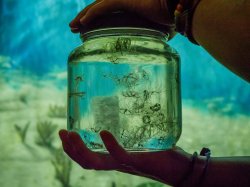How to Treat a Jellyfish Sting and Other Beach Season Tips
Biology Professor Paul Bologna shares advice on neutralizing jellyfish stings, sharks you may spot at the Jersey Shore and more tips for the summer season
Posted in: Faculty Voices, Homepage News, Research, Science and Technology, Uncategorized

Along with your sunscreen and towel, be sure to pack some white vinegar for your trip down the Shore for summer 2023.
Paul Bologna, associate professor of Biology and Molecular Biology at Montclair State University, is an expert on jellyfish, marine biology and aquatics. Here, he shares tips for beachgoers to keep in mind if they spot certain sea creatures this summer.
DIY remedy to treat jellyfish stings – that doesn’t include urine

Jellyfish are common along the beaches of the Jersey Shore, including the small, invasive clinging jellyfish (you may spot them in shallow water, between May and June), Portuguese man o’ war (which have a substantial sting) and occasionally in the fall, Caribbean box jellyfish.
If you experience a jellyfish sting, Bologna has just the thing to help – and it has nothing to do with that unpleasant remedy you’ve seen in the movies.
“Urinating to treat a jellyfish sting is a myth, so we should not even give it the time of day,” Bologna says. More effective remedies include a product called Sting No More, which treats Pacific box jellyfish stings but is known to be effective against many venomous jellyfish. And, for a DIY option:
- Pour white vinegar after the initial sting. This immobilizes any stinging cells which have not fired.
- Then, pour salt water across the sting area to wash away any remaining tentacles. DO NOT pour fresh or bottled water over the area, because it causes osmotic shock to the stinging cells just immobilized and they will fire and continue to sting.
- Wipe the area with a clean, dry cloth and then apply a hot compress to the area. The heat helps denature, or destroy, the venom proteins.
Jellyfish aren’t the only potentially dangerous creatures to look out for when you’re out for a swim. “There are a few bad guys out there,” Bologna says. Stingrays also appear in back bays and beaches, and Bologna says there can be a risk of accidentally running into one and getting stuck by their barbs.
“This is why it is important to swim in designated areas with lifeguards.”
Speaking of scary sea creatures…
Shark sightings in New Jersey and beyond
These days, sharks typically spotted off shore in New Jersey include spiny dogfish sharks, blue sharks, mako sharks, tiger sharks and several others. And of course, “we certainly have great white sharks patrolling all along the east coast of the U.S.,” Bologna says. One of them, named Tancook, was detected last May off shore from the Delaware Bay.
“They exist in the area and could pose a threat, but this is unlikely to happen,” Bologna says. Sharks tend to come into the bays to give birth or come near shore to feed on schools of bait fish, or in the case of great white sharks, seals.
Beach and Ocean Safety 101
Just as plastic pollution causes harm on land in our communities, marine life is also negatively impacted. “Many birds, fish, reptiles and mammals are strangled or drowned due to discarded fishing nets every day,” Bologna says. Birds that scavenge on the beach, such as seagulls, are also affected because they accidentally eat plastic debris and starve with stomachs full of non-digestible material. Micro-plastics are also often laden with toxic substances, making their way up the food chains and poisoning animals.
You can help keep beaches clean and sea creatures safe by gathering all of your garbage at the end of your beach trip and disposing of it properly – and if you spot some discarded plastic on your way back to the car, toss that, too!
As for the sand and beach itself, Bologna says that almost all public beaches are monitored for harmful bacteria and when those levels are exceeded, state or local governments will close the beaches. However, “bacterial levels often increase dramatically after rainfall events, because bacteria gets washed in from land sources such as deer, dogs and geese, as well as sewage overflows,” says Bologna. “Watch for warnings after big rainfalls and be mindful that water testing often takes 24 hours – water test results may not be in if there was rainfall the day prior.”
What’s it like to be a marine biologist?
Recently, Bologna and his research students have been studying seagrass restoration in Barnegat Bay and jellyfish abatement.
“We are working with Save Barnegat Bay and the Berkeley Township Underwater Search and Rescue Squad to ‘Stop the Sting,’” Bologna says. “This project works to educate homeowners and communities about jellyfish and how, through scrubbing bulkheads and docks, we can disrupt the life cycle and potentially limit the numbers of jellies, especially in the developed lagoon regions of Barnegat Bay.”
When it comes to encountering creatures and other ocean phenomena, summer proves to be an exciting time for Bologna.
“This is when I get to be in the water and do my work. It provides me the opportunity to pursue my research, but it also allows me to engage Montclair students in research and teach the next generation of scientists the hands-on approaches they will use as they move on to the next stage in their careers.”
For more information about our Biology department and its programs, visit montclair.edu/biology.
